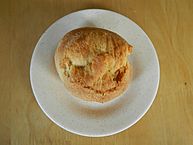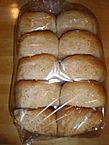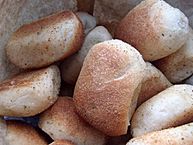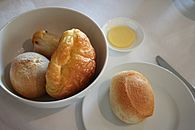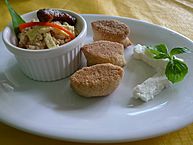Pandesal facts for kids
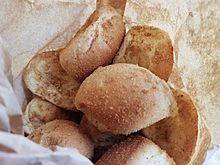 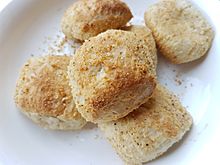 |
|
| Alternative names | Pan de sal |
|---|---|
| Type | Bread |
| Course | Breakfast |
| Place of origin | Philippines |
| Main ingredients | Flour, yeast, sugar, salt, oil |
Pandesal is a super popular bread roll from the Philippines. People often eat it for breakfast. Its name means "salt bread" in Spanish, but it's actually a little sweet! This yummy bread is made from flour, yeast, sugar, oil, and salt.
Contents
What is Pandesal?
Pandesal is a type of bread that uses yeast to make it rise. Bakers shape the dough into long logs. These logs are then rolled in fine bread crumbs. After that, they cut the logs into smaller pieces. These pieces are left to rise even more before they are baked.
How to Enjoy Pandesal
Most of the time, pandesal is served hot. You can eat it plain or dip it in coffee, hot chocolate (called tsokolate), or milk. Many people also like to add toppings. You can put butter, margarine, cheese, or jam on it. Peanut butter and chocolate spread are also popular choices. Sometimes, people even make sandwiches with eggs, sardines, or meat inside.
Pandesal tastes and feels a lot like other breads. It is similar to pan de agua from Puerto Rico. It also reminds people of the French baguette. And it's like bolillos from Mexico. Even though its name means "salt bread," pandesal is usually a bit sweet. Most bakeries make fresh pandesal every morning. This is because it is a favorite breakfast food. Some bakeries even bake it all day long!
Different Kinds of Pandesal
There are a few different versions of pandesal you might find.
Modern Pandesal
Some pandesal sold in supermarkets and bakeries looks different. It might be less crusty and lighter in color. These types also tend to have more sugar. Traditional pandesal has only a small amount of sugar.
Island Pandesal
On Siargao Island, which is famous for surfing, there's a special oval-shaped pandesal. Locals call it "pan de surf" because it looks like a surfboard. This bread is often baked in simple ovens. These ovens use coconut husks as fuel. You can usually find it sold next to pan de coco, another sweet bread.
Healthy Pandesal
Sometimes, dried and ground-up malunggay leaves are mixed into the flour. Malunggay is also known as moringa. Adding these leaves makes the bread more nutritious. This version is called "malunggay pandesal" or "malunggay bread."
Fun Flavors of Pandesal
A very popular new type of pandesal is ube cheese pandesal. It has a yummy filling made of purple yam (called ube) and cheese. This bread is usually purple, just like other ube dishes. Other new flavors include chocolate, matcha, strawberry, and blueberry.
Pandesal's Cousin: Señorita Bread
There's a soft, yellowish Filipino bread roll that looks like pandesal. It's called Señorita bread, Spanish bread, or pan de kastila. This bread uses eggs, milk, and butter or margarine. Unlike pandesal, it usually has sweet fillings inside. It is not related to the Spanish pan de horno.
The Story of Pandesal
Pandesal has an interesting history in the Philippines.
Early Days of Bread
Before pandesal, there was a bread called pan de suelo. This means "floor bread." It was the local Spanish-Filipino version of the French baguette. It was baked right on the floor of a wood-fired oven called a pugón. This bread was made with wheat flour. It was harder and had a crustier outside than today's pandesal.
Wheat is not grown much in the Philippines. So, bakers eventually started using cheaper flour. This new flour was not as good quality. This change made pandesal softer and doughier.
Pandesal Becomes a Favorite
Pandesal became very popular during the American colonial era. This was in the early 1900s. At that time, American wheat became easy to get and was cheaper. Since then, pandesal has been a main breakfast bread in the Philippines.
Baking pandesal in pugón ovens has become less common. This is because there is a rule against cutting mangrove trees for fuel. So, bakers now use ovens that run on gas instead.
Gallery
-
Pandesal with malunggay
-
Traditional full Filipino breakfast with kesong puti, pandesal, sinangag (garlic rice), and a longganisa sausage
See also
 In Spanish: Pan de sal para niños
In Spanish: Pan de sal para niños


